Summary of the article What is Gauteng pointing to?
In South Africa, the corona figures are falling again, after the Omikron outbreak a few weeks ago. It is now clear that Omikron has had no dramatic impact in South Africa – hospital and death rates have remained much lower than during previous waves in that country. This is now also recognized in the media.
The concerns in the Netherlands are focused on the ‘what if’ scenario: “Suppose that Omikron is more dangerous in Europe compared to Delta than in South Africa.”
There are significant differences between South Africa and the Netherlands: The population here is older, it is winter instead of summer and the vaccination rate is much higher here. These differences are unmistakable, the question is to what extent they will have a positive or negative effect. We will only know for sure when the Omikron wave is behind us here.
However, what if Omikron behaves the same in relation to Delta in the Netherlands as it did in South Africa? It is only a hypothesis, but not illogical in the absence of hard data on the effect of the differences.
That scenario is calculated for the Netherlands in this article.
–
Read full article
Reading time: 5 minutes
A blog by Herman Steigstra and Eildert Slim
Gauteng
Since the outbreak of the corona virus in South Africa, we have been closely following the figures here, in the hope of finding indications there for what awaits us in Europe and the Netherlands in particular. The first messages were hopeful, this variant was admittedly much more contagious, but at the same time much milder. The province of Gauteng is the largest and most populous province of South Africa and with 15 million inhabitants it is also somewhat comparable to the Netherlands. Naturally, the population composition is different there than here, the average age is lower there and the social climate is also different there.
In the run-up to this fourth wave, you are anxiously waiting: when will we have reached the top and the hospitals will not be flooded any time soon. In the background we have already made some calculations with the first figures and they also looked rosy, but it was by no means certain whether our assumptions could be copied from Gauteng.
The numbers there are now falling sharply and the end of the epidemic seems to be in sight. Almost all measures there have now been scaled down (but it is summer there). Let’s first look at the global picture over the past two years and then look at the PCR figures in particular.
The first thing that strikes you is that we are dealing with four separate waves, corresponding to the four variants, each with its own contagiousness. This makes it easier to better monitor and understand the behavior of the epidemic. The third wave is the Delta variant, which appeared there in May (it was almost winter there) and had worn off in September. The fourth wave is the Omikron variant, which was the first in the world to be spotted there in mid-November. Compared to the Delta wave, a short, bright peak, which also fits with the image that Omikron is 2.5 times more infectious than the Delta. Previous variants were always “only” 30-50% more contagious.
We have to realize that the number of positive tests is not everything. Much less testing is done in South Africa and it could well be that a different Ct value is used there, so that the absolute figures are not easily comparable with those in Europe. We do see that the surface under the Omikron wave is much smaller. If you calculate it precisely and also complete this wave mathematically, only 25% infections have been detected at Omikron compared to the Delta wave.
What can we expect in the Netherlands now?
We now proceed under the assumption that what we see in South Africa can be translated to the Netherlands. Then we can compare the Delta and the Omikron waves in a common graph. To this end, we project the peaks of the figures for the Delta and Omikron variants into the figures for the Netherlands. The Delta figures are now complete when it comes to the tops of the curves, the projected African peaks are then indicative of what we can expect in the Netherlands. The big difference with South Africa is that our Omikron wave is rising, while the Delta wave has not completely disappeared.
Admission figures
The peak of the number of admissions with the Delta variant in Dutch hospitals was around November 28, in Africa it was already around July 3, the start of the winter season there. If we move this wave in Gauteng to November 28 and scale it so that these two waves coincide, we can scale the Omikron recording wave equally:
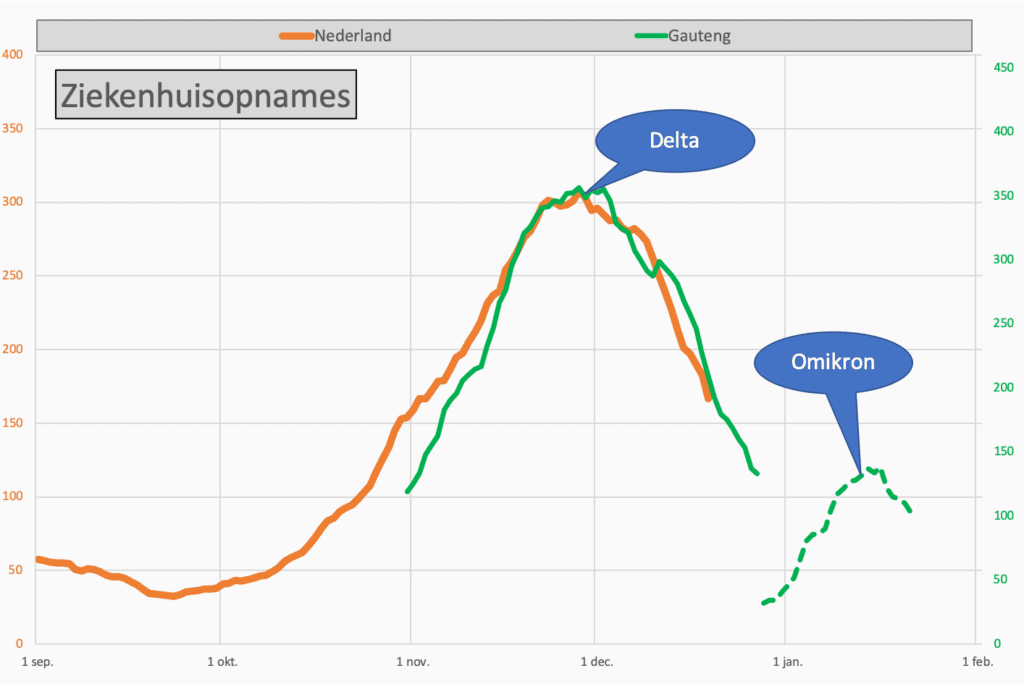
In this graph we read that the number of admissions in the Netherlands (orange) increased to approximately 300 per day in the Delta wave and 350 in Gauteng (green). At the Omikron in Gauteng, the number of hospital admissions per day remained at 138 per day. If we read that number on the Dutch scale (orange, left), it would be about 120 per day. But of course that remains an indication, reality may look slightly different.
It is difficult in the Netherlands that the Delta variant still determines the image during the recordings, despite the fact that the Omikron seems to be dominant here since the beginning of this week.
PCR figures
If we compare the PCR figures from Gauteng with the Dutch figures, we get this graph:
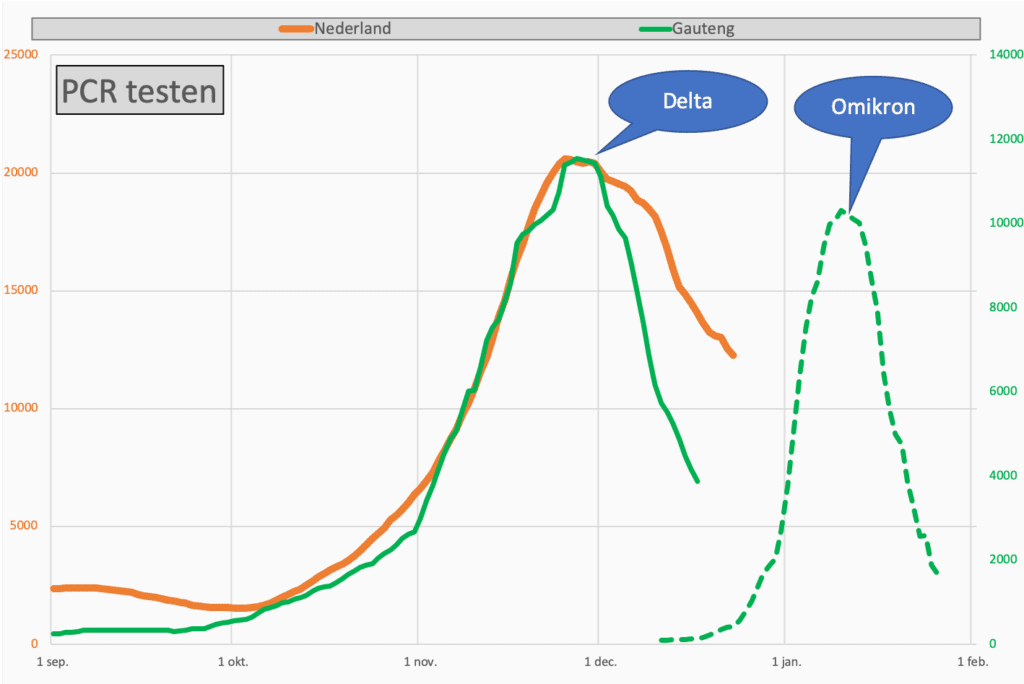
What is striking is that the right flank of the PCR figures in the Netherlands is fainter than in South Africa. That could be related to the “Madrid effect”, but also partly with a slowly growing share of Omikron. In the Netherlands there is also much more intensive testing with probably a higher Ct value. With an almost equal number of hospital admissions for the Delta variant, there is a double number of positive results in the Netherlands compared to Gauteng. In the coming weeks it will become clear how the PCR figures will go.
Hospital Occupation
What is now clear is that fewer people end up in hospital after infection, and that the length of stay is considerably shorter. Also, the treatment itself is much milder in Gauteng. Only 10% of the patients need oxygen, while this was still almost 100% with the Delta variant. All in all, this results in a much lower burden on the hospital there. Projecting these figures to the Dutch situation would yield this graph:
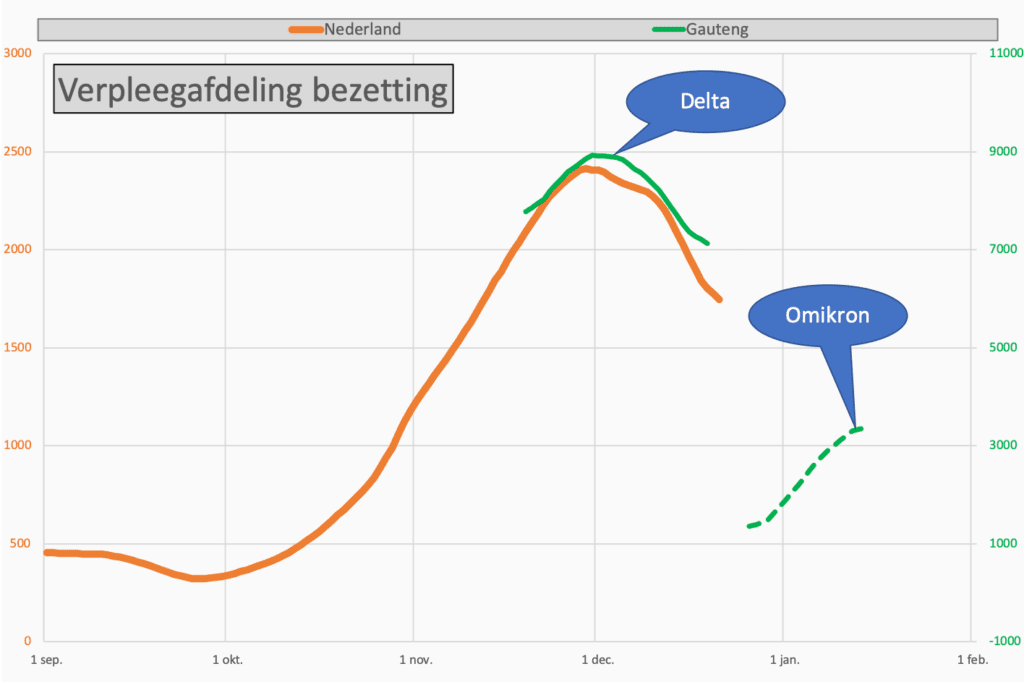
Despite the much higher contagiousness, which means that relatively more people are admitted in a shorter time, we see a much lower occupancy. If the figures in the Netherlands were in the same proportion, we would have an occupation of more than 1000 patients with Omikron in mid-January. Of course, this is still under the assumption that South Africa is somewhat a model for the Dutch figures. All figures known so far in the Netherlands still point in the same direction. We won’t be able to say anything definitive about this for a week.
IC occupation
We can also make the same graph for the IC occupancy. The same story as with the occupation of the nursing ward. In Gauteng it is even seen that the number of patients who eventually end up in the ICU is even lower in proportion. This is again most clearly visible in this graph:
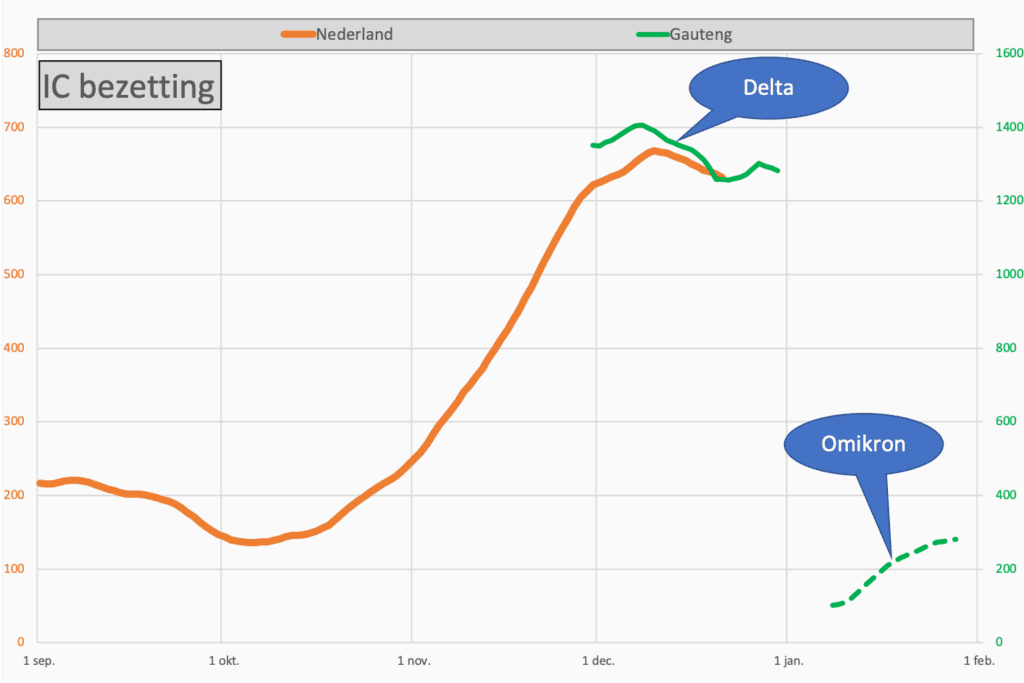
The RIVM supported the choice of a heavy lockdown with a prognosis that up to 5000 patients would be in the ICU. With this indication from Gauteng, we would in any case remain well below the current 600 occupied IC beds.
death
The number of deaths can be expressed as a percentage of the number of infections (IFR) or the number of cases, the Case Fatality Ratio (CFR). The problem is determining the number of infections or the number of cases. That has everything to do with the test policy. The more tested, the lower the CFR value. This is the graph for the CFR value in Gauteng:
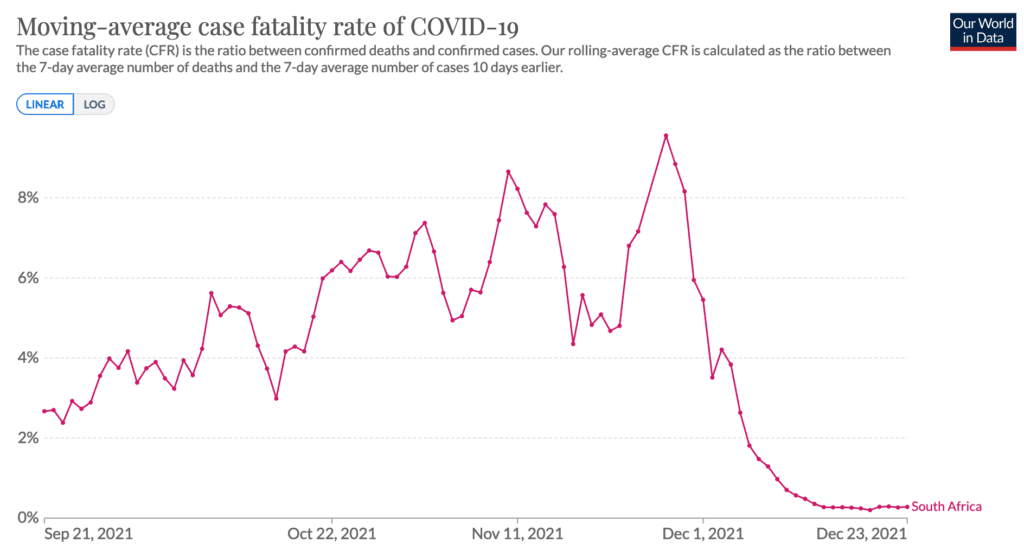
Since the arrival of the Omikron variant, the CFR has fallen from an average of 5% to 0.25%. What this value will come to in the Netherlands is still a big question. There are no known deaths yet from the Omikron variant, it will take a few weeks before we can form an impression. But it does not seem unreasonable to think that the number of deaths here will also fall sharply. In contrast to South Africa, we are still dealing with a slowly fading Delta variant.
You have just read: What is Gauteng pointing to?
–


